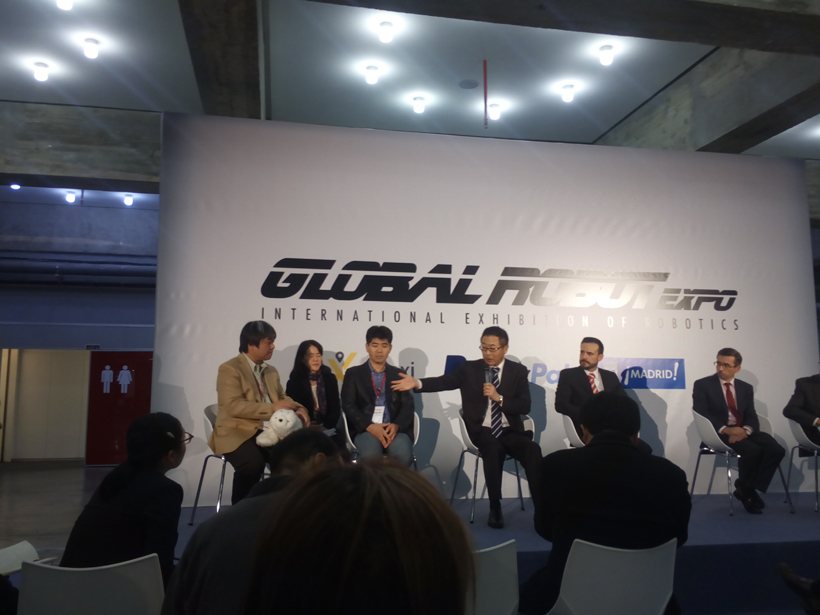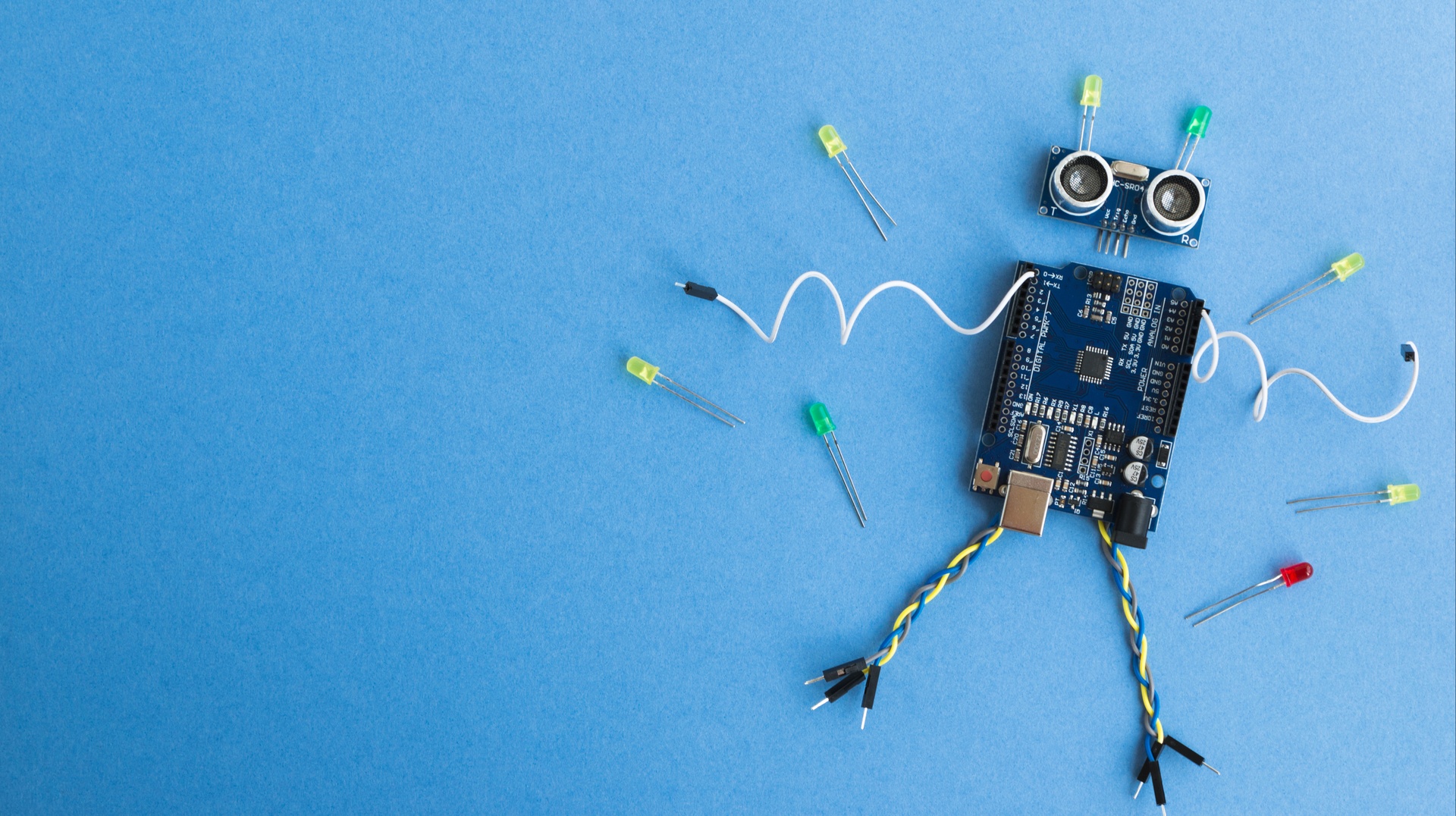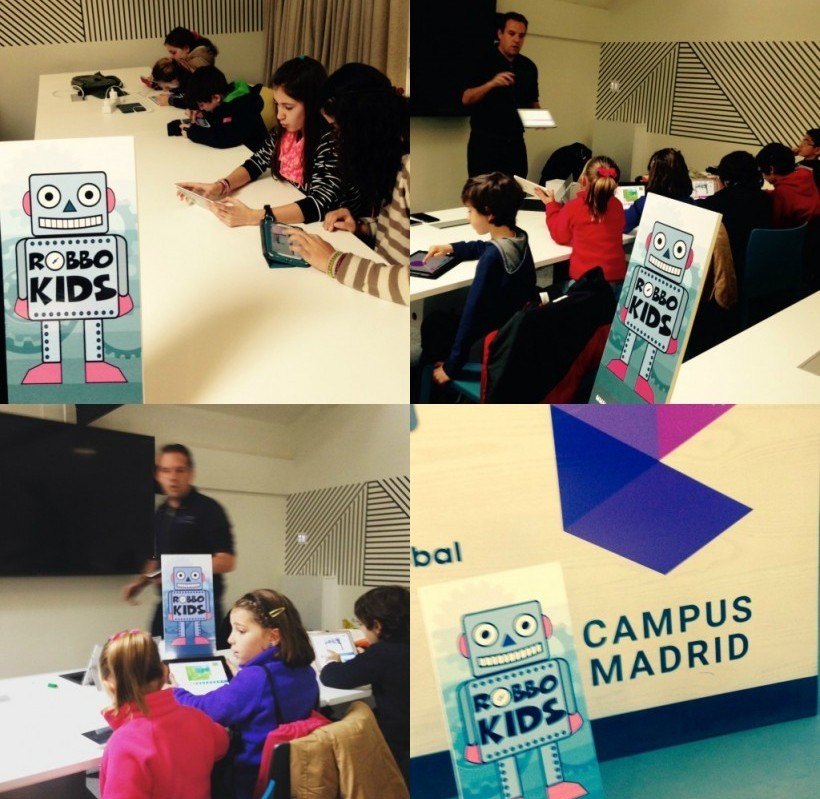Global Robot Expo: Educational Robots, From Emotional Robots To Early Child Programming
Kazuhiko Koshikawa, Ambassador of Japan, surprised us with a perfect Castilian language. Then he left us perplexed: He began to speak about Juanelo Turriano, the watchmaker of the Court of Charles I, and his "Stick Man". Besides watchmaker, Juanelo was a mathematician, astronomer, engineer, architect... His real name was Gianello Torriani (he was born near Milan in 1501). The Milanese where he lived became part of the empire of Carlos I and V of Germany, and Gianello was called to Toledo by the ambassador to become the court watchmaker.
In addition to building a variety of clocks, some of which were complicated astronomy gadgets (it is said that Carlos I understood watches as truly scientific instruments), through his knowledge of mechanics and watchmakers, Juanelo also became builder of automatons, some of which are preserved in Europe. However, the most famous of them, the "Stick Man" has left no trace, to the point of becoming a legend. It is thought that it was installed around the street of "Stick Man" in Toledo (Spain), close to the cathedral. Apparently, it was burned by the Inquisition when it was decreed to be possessed by Evil. It is believed that its intention was to raise money, maybe for Juanelo itself, maybe for a charity hospital that was being built at that time.
It is said that the Stick Man had a slot where people could insert coins, and as a sign of gratitude, it genuflected. Some believe that he was led through the streets of Toledo by rail and others that it was winded and it walked on his own feet. Since there has been no trace of its planes, there is no way to confirm it. Since 1987, there is in Spain the Juanelo Turriano Foundation, responsible for keeping the memory of the Italian wise and his work.
500 years after that event, Kazuhiko Koshikawa recalls it to celebrate the appearance of the first humanoid in Spain, during the opening ceremony of the Global Robot Expo held in Madrid. Koshikawa considers that this first edition of the fair is the beginning of a cooperative relationship to share experiences and scientific knowledge between Japan and Spain in the field of robotics. "Even the longest journey begins with one small step", says Koshikawa, according to an old Japanese proverb.

Global Robot Expo: Kazuhiko Koshikawa and Takanori Shibata presenting PARO, the Educational Robot.
Then the ambassador presented to Professor Takanori Shibata, from the Tokyo Institute of Technology. Shibata hold in his hands the seal PARO robot, which might seem a simple stuffed baby seal, but it is actually a complex robot with an initial development cost of 15 million dollars. PARO is generally used for patients with dementia and Alzheimer palliative care, but also in some countries such as Denmark is being used in special education for children with autism.
This robot approved by the US FDA as a medical device, has 32 processors, 3 buses, 20 tactile sensors that cover its skin, sensitive whiskers to touch, and a system of motors that activate its fins and body silently. Responds to touch, to be caught in arms, to be looked at, to temperature and light changes, to sound and the direction it comes from, and it is able to remember names, faces, and actions that generate a positive reaction in humans. It can simulate emotions and moods such as surprise, happiness, and anger, which helps creating the illusion that a relationship with it is taking place. It also emulates the sound of a real baby seal. As with real animals company, it gives positive effects to alleviate depression and anxiety, but it is not necessary to feed it and it never dies (although you cannot machine wash it!).
https://youtu.be/ckXe8YCzxsg
More Emotional Robots
1. Aisoy Robotics.
AISoy1 V5 is an emotional robot: It is based on social skills as a way to build an emotional bond between children and the robot, so that the child's learning experience gets to be more attractive and durable. You can keep an interaction with it just as the one that occurs between humans: It reacts to touch and to glances; it understands speech with some limitations, though we are reported from Aisoy Robotics that it is being debugged to improve understanding and to be able to maintain a more or less intelligent conversation with it; thus, it may be used as a tutor to be consulted, to respond reactively, or in a way that when it hears some issue, it would proactively request if the child would like to know more about it.
https://youtu.be/Gb5q08fikAw
AISoy1 V5 can be used in two ways:
- Everything in free form programming, with very simple and visual programming algorithms, Scratch type, for 8-12 years children. For children a little older there is a Blockly version to be handled with a tablet; this version can also be used with more professional programming language with which to add all the ingredients for different purposes. Two interesting and different examples are the one from Valencia, where they are doing drama classes in 60 schools of various kinds, with transverse projects (in the sense that it is not only based on programming the robot, but on contextualizing the play, developing dialogues, costumes and scenery design and building, and then run the play..); and France, where they have used the robot in the installation of a home automation system. What they do there is to program the robot as a method of learning technology and programming.
- The other way is a self- learning mode, which has a proactive function, as mentioned before, but also reactive in the sense that they are developing a series of puzzles, mini -games, etc. to be proposed without programming, allowing to obtain pills of information and in some cases, to investigate a certain subject outside the robot, and then talk to it about what it has been discovered, so the robot can answer with a reinforcement, usually positive, or support if the child is required to improve.
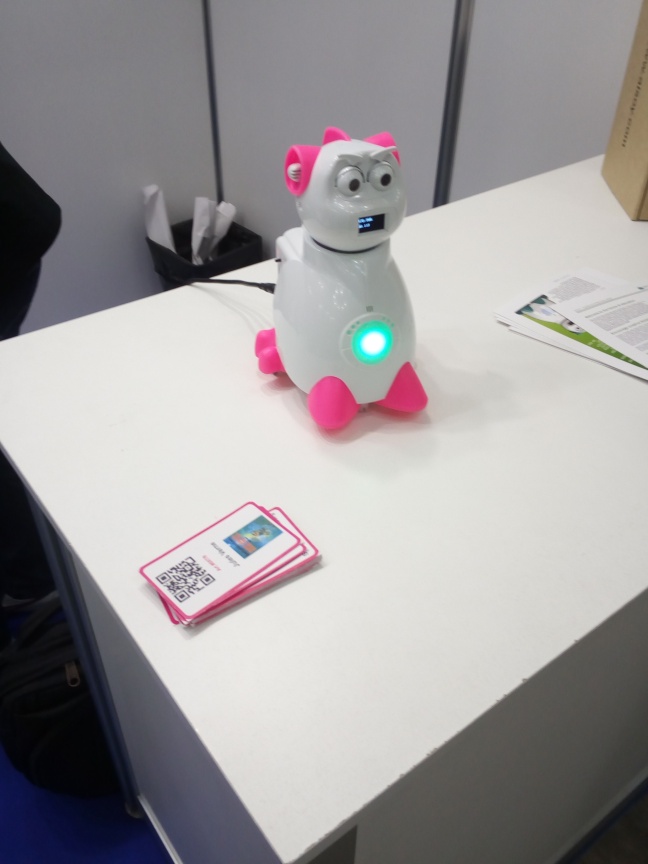
Aisoy1 V5 Educational Robot Aisoy1 V5 Educational Robot rtec Educational Robot
- Special education needs: There is certainly a case in the US of a child who did not speak for several years; then his mother established six weeks of small routines with the robot, and he began to articulate words and to acquire vocabulary.
- Training the trainers: In relation to resources for trainers, in Aisoy Robotics they are working with content that can be consumed in the classroom in general, not just for the technology classes.
- New uses: A surprising use of the robot is given by a customer in the Netherlands: It has been placed at his mother as a companion robot, and she’s having fun with it.
- Future steps: Developing all share -based language and programming, which will likely result in new functions and new types of robot interaction.
2. Casual Robots.
Casual Robots offers Reeti, a product that is being used a lot in education, because the most important thing about it is that it generates empathy. It has always been a difference between machines and people, where people identify the robot as a computer. From Casual Robots they try to prepare people, so that part or that utility gets more fun to work with.
https://youtu.be/TNjGqXpAVOw
- In schools: In school, we must take into account the price. You need to range from products where there is no per-pupil cost of more than 100 euros, to Pepper, a robot able to communicate and interpret the emotions, which is also used in education and worth more than 20,000 euros each. The important thing is it to be flexible, scalable and useful in teaching.
- Special education needs: In special education, almost all lines of robotics have it into account, for both children and elderly. It is proven to be useful.
- Future steps: In Casual Robots there are plans to create in Madrid the largest center of Europe about robotics, to pioneer the attempt to create a cradle of new generation where robotics are enjoyed the same way as computers were enjoyed before.
Assemble Before Use
3. Artec.
Artec is a Japanese company which works as a supplier since 1960. It offers the construction of figures with parts (lego type) that are programmed in Arduino style. It has three different types of programming, from the simplest to the most complex. It allows to learn how to program step by step. The largest model available (Robotist Advanced) shows up to eight different shapes, as an example of what it could be created, because this package is fully programmable and allows to build anything imaginable.

Artec Educational Robot
- Advantages: They are so easy to build because they are based on parts, that the child spends most of the time learning how to program them, not only assembling the structure.
- Special education needs: They have larger blocks (Primary 30) which are easier to handle.
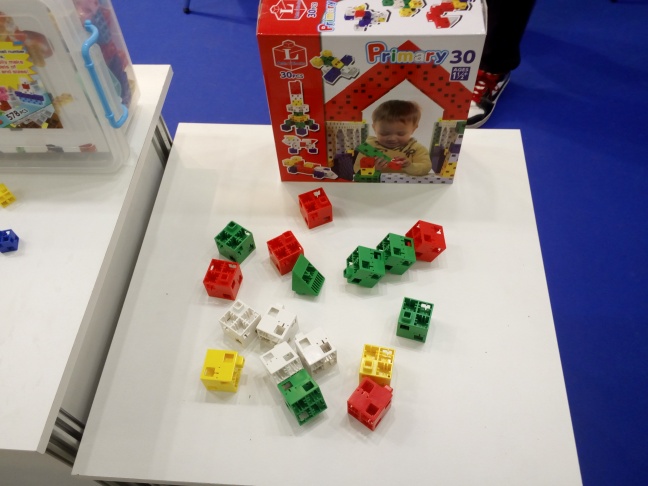
Artec Special Needs Educational Robot
- Experience in Schools: It is used in teaching mechanics and it is adapted to the Japanese official CV.
- Training the trainers: They do training for teachers to learn robots’ programming, so then they can teach children.
- Feedback: They get the impression that it is a very cool system. Working in different countries such as Australia, where teachers told them that it is being very well received by children because they enjoy using it.
- Future steps: Create friendly devices; specialize in high school programming.
https://youtu.be/eU-h6Q0J4nE
Ready To Start
4. BQ.
To bring technology closer to people, it is necessary that children can see how things are done and find out what's inside. Zowi is a robot from BQ that from the first moment right out of the box is working, and it moves, and interacts with you. It has the basic functions: It walks, it dances... But these functions, after a time, get the child bored. So you can drive it from the tablet or phone with a remote-control application. It is also programmable. Projects introduced at the application each time will unlock, so the kid will be doing increasingly more and more things. It does not end there; if a child is very interested in programming, he or she can go to Bitbloq tool, a BQ Web-based Scratch programming type page, which is simpler language they can easily understand. If they also are very interested in technology and want to learn more about the robot, it can be opened, you can see what's inside, you can see the plate, the sensors, you can connect or disconnect it, to understand why it works that way. To understand technology, you need to have access to it. Not only is intended that children use or play with technology, but also that they learn to create technology. This is a project for younger children, aged 8 years.
https://youtu.be/aw7kQ4sZfLE
- Experiences in Schools: They are working with the Community of Madrid in some educational projects to feed the technology subject.
- Traing the trainer: They train teachers so that they can then deliver technology and robotics classes to children. In an Institute of Las Rozas BQ has a technology workshop for kids at ESO. They also collaborate with publishers in developing educational content. They give support to teachers to get to know which projects are they going to develop.
- Special education needs: They are carrying out projects.
Programmable Robots
5. Aldebaran Robotics.
At Aldebaran, they are programming NAO, which is very simple. It is widely programmable, from a very basic level. They are like little boxes, which are chained. Tasks can be done in series and sometimes in parallel. For instance, it is not possible to get up and sit at a time, because they are movements that get in conflict, but you can make it look to someone or something while it is sitting, for example. This would be simple. Then you can program in Python, which would be another step for boys and girls in primary or secondary. Python also includes roboticists.
https://youtu.be/Tq4ApeBVCXM
- In schools: This is a platform that is much more developed than in the rest of robots. It has two cameras, with which it is possible to do developments, for example face detection; algorithms are already prepared so you can use these calls to these functions, so that a child will see very easily how the robot is doing what he wants in a few steps, without having to make a disproportionately large development, that in a class year period may not be feasible. Thus, it is adaptable from children to adults. The documentation is on their website. The API is available in both C and Python and has many functions. For instance, the most noteworthy are gender detection of a human face, how old you are, if you're smiling... It gets to know what color is the clothing worn by the person, it can also detect obstacles...
- Special education needs: There is a program called ASK Nao (Autism Solution for Kids) that is focused on children with autism. Nao recreates a state; for instance, it gets to mourn. Then it asks the child "What do you think, am I sad, happy, or elated?”, for instance three states, and the child has to answer. If the child responds correctly, he or she is encouraged to continue with these questions. After a few questions, it dances as a reward. If he or she did not say the right answers, the child is encouraged to keep trying, because he or she will surely learn how to detect different moods. The child keeps more attentive with the robot than with an adult.
- Training the trainers: Ideally, they should also know how to program robots to tell the child what are they programming; every adult has a child inside and it gets out when NAO gets running. Everyone was delighted with the course, not only in terms of programming, since you can even create movements, create a dance, put the music, save it all and it will represent the choreography with the music always in the same way, without mistakes.
- Future steps: Aldebaran are trying to get into the schools, so that they understand the educational ability of the product, and later also for custom developments. They collaborate with companies and make completely customized developments.
6. Midland.
In Midland, the educational issue is twofold: The humanoid robot, which is programmed with certain movements, and then using the software that is passed from the website of the manufacturer, with which it is possible to make all movements that can we wished. It consist on developing everyone’s imagination.
With the humanoid, it is possible to learn other things besides programming skills. For example, if you want the robot to lift one leg, it will have to tilt the body to compensate for the weight and avoid falling down.
https://youtu.be/rMq2V8CR_VM
- In schools: They are working with robotic short time, only two months. They only have the humanoid. Many schools have attended that want to develop this type of activity with children.
- Training the trainers: They don’t work directly with teachers. They work with distribution. This training should be given to the dealer and the dealer to the concerned school, college or institution.
- Feedback: They are using the website. They send that information to manufacturers when they do not make the robots, and to developers when it is its own production (although they do not make educational devices).
Training In Robotics
7. Camp Tecnológico.
Camp Tecnológico provides training in Spain. They have a coordinator in Madrid and the headquarters are in Bilbao. They provide monitors and educational materials, although they are not developers of robotics products. They use educational content for ages 4 to 17 years. They work as a preschool for schools, as education modules and weekend camps. They use robots that give a first approach to technology, so that children will understand the proper mindset to develop something like this, as a sequential thought. The next step is to move to Scratch, a programming block, and already knowing Scratch a whole world of possibilities opens up. The idea is to start from the very basic, understanding main ideas and concepts, and then to make a complexity design towards more difficult concepts, such as Arduino, and above all, teaching them technology and then after posing them challenges, so children will have to think about how to perform them. A problem arises and they seek the solution. Technology comes first and then we propose a challenge to see what they have learned and how this technology is applied.

Camp Tecnológico, Educational Provider in Robotics
New Technology, Programming, And Robotics Subject
From the academic year 2015-2016, it has implemented the new Technology, Programming, and Robotics subject in the curriculum of the Community of Madrid for first and third courses of ESO, expanding to second and fourth ESO courses in the 2016-2017 year. If the trend was bilingualism before, now that all institutes are bilingual by 80-90% in Madrid and other Spanish communities, the new trend is becoming bilingual and technologic. It is an open market in which you can work.
8. Crea Robótica Educativa.
Crea Robótica Educativa offers courses of all kinds: For students, after-school, curriculum and teacher training. Hey range from 3 to 18 years with different robotics kits and 3D printing. they usually work with Parents Associations, the school gives them the space and they organize extra-curricular classes, so they go to the center to teach their classes.
- Training the trainer: They train teachers, they help them in the selection of equipment, especially now with the subject of Technology, Robotics, and Programming, as they are not used to using this type of technology. They helped them to select the equipment and to understand how to manage it, planning their activities in class.
- New uses: Students always raise doubts that older we cannot think. Enthusiasm and eager to learn is perceived. They are trying to break some walls, the belief that technology is complicated. When starting as young, they realize that they can do anything from a mobile application, even to control a robot. Technology are encouraged to come forward and the students get more prepared to their careers. The smaller the child, when they will give them a talk about robotics, pose very difficult questions to answer: How far will robots arrive? Will we work for them someday? Those are issues that are already coming in the field of robotics philosophy, ad educators not know how to answer.
- Special education needs: Crea Robótica Educativa has done some studies on how to incorporate new technologies to help students with disabilities to work in a normal way and not feel displaced in this field. They work with certain associations that occasionally come to do a course and they see the uptake and acceptance of these students. The majority are doctoral robotics students from the Carlos III University and are used to field studies. They attempt to study how children understand things. For example, you cannot teach an 8 years child to make 3D printing without knowing first what the lever law is or where electricity comes from. They do studies for their teaching content get as adapted as possible to their knowledge of curriculum classes.
- Feedback: In Crea Robótica Educativa, even if they do not feedback directly to manufacturers, they do create their own versions or change the educational content that some manufacturers provide, in order to adapt it as much as possible to the ages of the students. These contents are used in their school classes. Over time, they may open it or make a book about how to control robots, so that it suits every age.
- Future steps: To set the online store, to market the products of educational robotics, 3D printing and drones. To expand, not only to Madrid, but to other provinces or communities.
9. Ildesoft.
Ildesoft presents Dash & Dots, a robot for children to learn to program. It is designed in the US. Ildesoft import them throughout Europe. You can handle a robot from a tablet without knowing how to read or write, but it can get complicated as far as the imagination of the child scope (since picking the house, to train the dog).
https://youtu.be/VP-SNXBWI84
From technology and the way of thinking that programming has, which is based on dividing a large problem into multiple small ones, it helps not only to learn programming but learning many other subjects. There are multiple studies in the US that show that children who have had contact with programming have better grades than children who did not.
In Spain, according to one study, children spend about an hour and a half a day to study and one and a half to play. This allows us to do both simultaneously.
88 % of parents interviewed by Ildesoft in Spain think their children should have access to this type of education, but only 25% have real access through extracurricular activities or academies. Mothers are more interested in their children getting into this world, but then, when going to buy the toy, it is chosen by the father. It's not a toy for boys or girls. Amazon, for instance, has made a very wise decision, and it is not allowed to select the toys by gender, there are no toys for boys and girls. It is a toy that in the case of Ildesoft, has a higher rate in girls than in boys. When creating the toy, they attended a convention of toy in the US and worked with them as importers, raising questions such as: Should we do it with more wheels, or less? We want I to look more like a car or not? Ildesoft target all audiences, they want "less princesses and more engineers".
- Feedback: In Youtube, in the community, every five minutes there is something new: Exiting a maze, fighting knights kids do, recordings of the girls so robots will be able to remember the dates of birthdays, older brothers who programmed so that when the younger brother enters its room an alarm would sound saying: "Get out of my room"; it is the imagination. One of the great advantages is that robot technology is in applications. Whenever they are updated, the robot makes new things. That makes that the robot which was sold eight months ago, can do more things now than then. It is not a toy that can be left behind or that won’t advance with technologically. Every day is new.
- Training the trainer: They do through the classes’ content, the teaching units: Teaching trigonometry, how to teach geography, mathematics... The robot does not need to know where Spain is, but if you put a map on the ground in a class of 5 years old children and the robot is programmed to be placed on top of Spain, they will always remember it. Child focus is much higher than with an adult, because he or she sees the robot interacting with him or her. In Spain, less feedback is received from teachers, because the subject of programming has caught many institutions and many schools offside. Training in many teachers is not yet optimal. In the US it is, in fact they create teaching units altruistically in Colorado, Hawaii... They are proposing improvements, including robots: What sounds have to do, what light, what movement they see it interacts better with children.
- Special education needs: By now, Ildesoft is doing very specific things. For example, in Caritas, they have donated a robot. They do not want a country of technology users; they want a country of technology creators. It is as simple as having a tablet to do so. They would be thrilled that in Caritas, within five years, one child will have thought of a new way of doing, for example, a laparoscopy. In the US, they have received requests from associations for children with special educational needs, especially in autism. Autism has been the key, or anyone with a difficulty of movement, motor. It is not yet documented. At this moment, they are testing with people they know.
- Next steps: To do something appealing to people, closer to everyone; that the robot will get to do more things, that it will do those things in the way a child wants to do them, which is who will be using the robot. A few years ago, the focus in schools were languages; now in schools we see that being bilingual is normal. Probably, within ten years, children will be better prepared than we were when we went to school. Same thing here. English is spoken by 600 million people in the world. Today there are more than 50,000 million devices connected, with their language, which is programming, and has many more uses. The robot usage data is not collected by privacy issues. In fact, the robot does not carry a camera, because it goes to the room of a child. Yes it comes with an adapter to put a mobile phone and then have a camera, if that is what parents want, but the robot itself cannot record. The privacy of a child lies ahead, and it is a device for young children.
